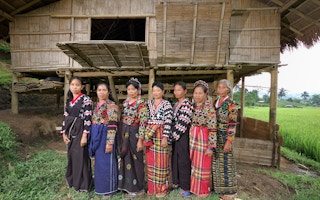Fashion and innovation meshed together during the Philippine Tropical Fabrics Month when office uniforms, designed by local artisans and made from tropical textiles spun out of natural fibres, got an airing.
Held in the first quarter of every year, the event highlights awareness of local fabrics and collaboration between industry players and research institutions to promote innovation in clothing production.
This year’s highlight was a fashion show aimed at boosting commercial production of indigenous tropical fabrics woven from silk as well as natural fibres drawn from plants such as banana, pineapple and abaca. Now a decade old, the exposition is geared towards farmers, handloom weavers of natural textiles, retailers and millers, and the producers of uniforms of various types.
The Philippines pioneered textile production in South-East Asia. Large-scale textile manufacturing began as early as 1906. But changes in global trade, preferential policies, lack of technical knowledge and investments saw the garment and textile industry’s export value drop from US$3 billion in the 1990s to about US$1.2 billion by 2016.
But the country remains competitive in the mid- to high-end market mainly for its prized embroidery and intricate design capabilities including handwoven fabrics made with indigenous fibres.
“
The materials (indigenous fibres) are expensive to begin with since they are not mass produced and there are cultural appropriations involved. Moreover, it takes time to come up with designs, even years. Besides, innovation doesn’t come cheap, especially if you work around sustainability issues.
Leo Lagon, chief executive officer, Bayo
Julius Leano Jr., officer-in-charge of the Department of Science and Technology’s Philippine Textile Research Institute (DOST-PTRI) says that the country needs to innovate and while there is a need to “differentiate what is truly Philippine textile, the cornerstone has to be science, technology and innovation”.
The Department of Science and Technology is helping the industry in areas such as new natural dyes, which replace toxic chemicals in the processing of textiles, while opening up opportunities for communities and local manufacturers. Natural textiles have expanded from wearable items to nonwoven applications for filtration, the automotive industry, bags and footwear.
The Philippine Tropical Fabric Law (Republic Act 9242) prescribed the use of local fabrics for uniforms of public officials and employees to promote local production of textiles using indigenous materials and fibres, especially abaca and pineapple.
Abaca fibre, also known as Manila hemp, comes from a species of banana and is noted for its strength, buoyancy and resistance to saltwater damage. The Philippines is the largest producer of abaca accounting for 85 per cent of global supply.
Pineapple fibre, which is recovered from the plant’s leaves, is soft and lightweight and often combined with silk or polyester. It’s famously used in the country’s national dress called Barong Tagalog.
Leo Lagon, co-chief executive officer for homegrown clothing brand Bayo, shared at the sideline of the show that despite the law the main issue is antiquated government procurement rules which prioritise the lowest bidder.
“The materials (indigenous fibres) are expensive to begin with since they are not mass produced and there are cultural appropriations involved. Moreover, it takes time to come up with designs, even years,” Lagon explained. “Besides, innovation doesn’t come cheap, especially if you work around sustainability issues.”
Yet, government procurement law doesn’t take this into consideration, he said.
“The solution is for the government to adopt green procurement policies and buy from companies with emphasis on sustainability,” Lagon added.
After this has been implemented, he believes, the next challenge is how to prove these companies are actually doing it for the environment and not just for show.
This article was originally published on SciDev.Net. Read the original article.








